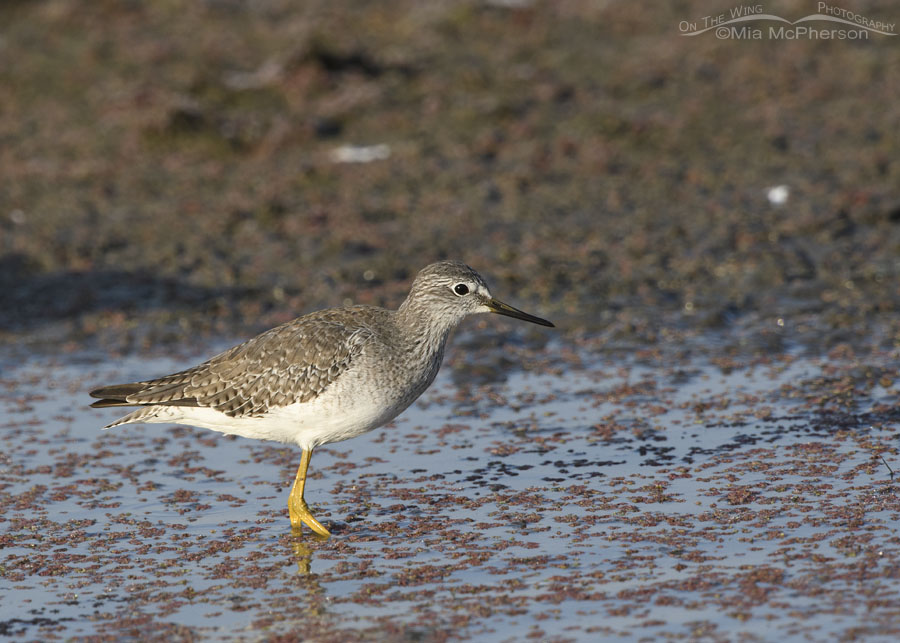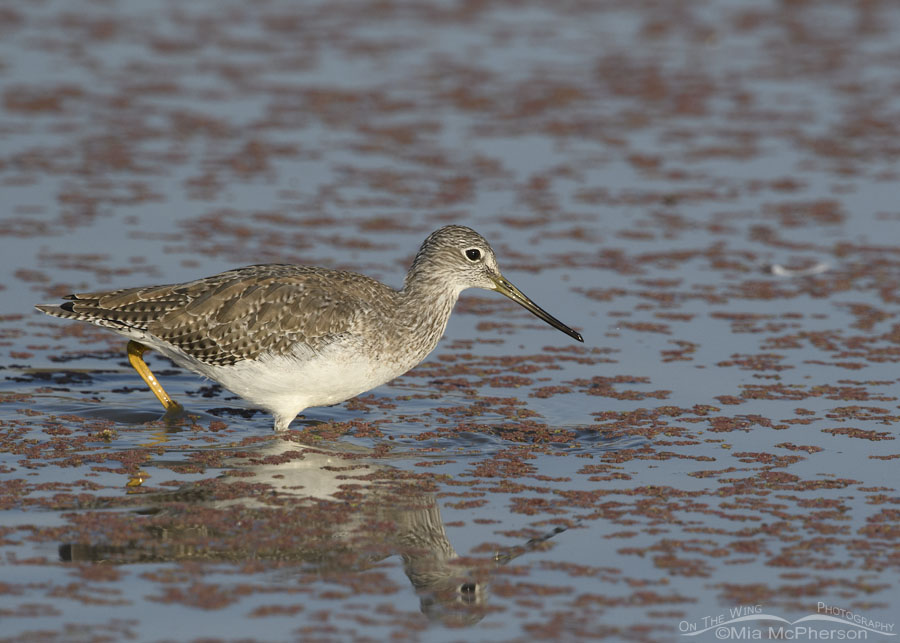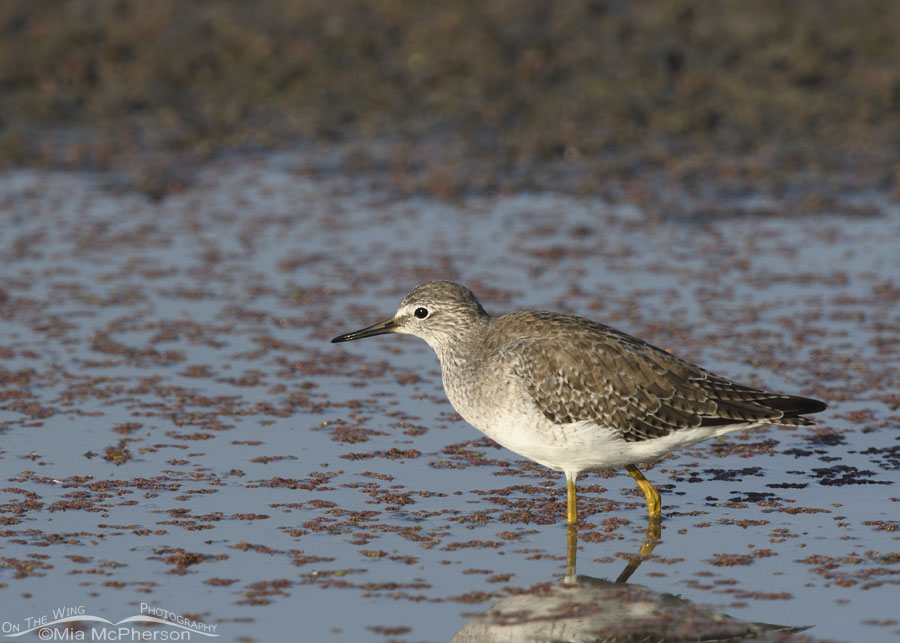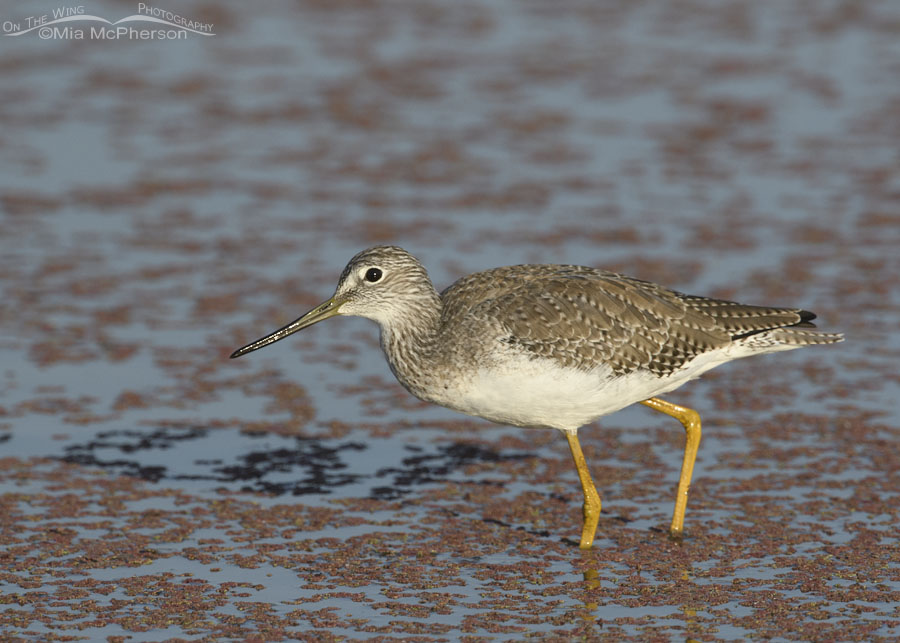 Lesser Yellowlegs in a shallow pond – Nikon D500, f7.1, 1/1250, ISO 640, -0.3 EV, Nikkor 500mm VR with 1.4x TC, natural light
Lesser Yellowlegs in a shallow pond – Nikon D500, f7.1, 1/1250, ISO 640, -0.3 EV, Nikkor 500mm VR with 1.4x TC, natural light
On Monday, I photographed both Lesser and Greater Yellowlegs foraging in a shallow duckweed-covered pond at Farmington Bay WMA early in the morning. Since I am asked for bird identification frequently, I thought I would do a comparison between the two species today. They have similar plumage, both have long yellow legs and are often found in the same type of habitats.
Lesser Yellowlegs, as their common name implies, are the smaller of the two yellowlegs species. Size in the field can be deceiving, though especially when both species are not present. That tip actually applies for all birds. I’ve seen people say that a Cooper’s Hawk was as big as an eagle, and we know that is not the case.
So how do I know which is which when I have only one of the two yellowlegs species in my viewfinder? I look at the bill.
Lesser Yellowlegs have straight, dark bills that are about as long as the width of their heads.
 Greater Yellowlegs foraging in a shallow pond – Nikon D500, f7.1, 1/2000, ISO 640, -0.3 EV, Nikkor 500mm VR with 1.4x TC, natural light
Greater Yellowlegs foraging in a shallow pond – Nikon D500, f7.1, 1/2000, ISO 640, -0.3 EV, Nikkor 500mm VR with 1.4x TC, natural light
Greater Yellowlegs have a longer bill than Lesser Yellowlegs which are about 1.5 times as long as the width of their heads. The thicker bills of Greater Yellowlegs also has a slight upwards curve to them compared to the straight bill of the Lesser Yellowlegs.
In addition to those differences, the nasal openings, or nares, of Greater Yellowlegs are further away from the feathers of their faces than the nares of Lesser Yellowlegs which are very close to the feathers of their faces.
 Lesser Yellowlegs standing still – Nikon D500, f7.1, 1/1600, ISO 640, -0.3 EV, Nikkor 500mm VR with 1.4x TC, natural light
Lesser Yellowlegs standing still – Nikon D500, f7.1, 1/1600, ISO 640, -0.3 EV, Nikkor 500mm VR with 1.4x TC, natural light
The calls of these two species are also different. Lesser Yellowlegs have a softer, hesitant calls which are usually one to two notes. Greater Yellowlegs have more strident and louder sounding calls which are typically three to four notes.
I am more familiar with the calls of Greater Yellowlegs because I see and hear them more often. When I only hear one to two note calls them I start looking for Lesser Yellowlegs for visual confirmation.
 Greater Yellowlegs with an eye towards the sky – Nikon D500, f7.1, 1/1600, ISO 640, -0.3 EV, Nikkor 500mm VR with 1.4x TC, natural light
Greater Yellowlegs with an eye towards the sky – Nikon D500, f7.1, 1/1600, ISO 640, -0.3 EV, Nikkor 500mm VR with 1.4x TC, natural light
I have also noticed that Greater Yellowlegs foraging behaviors are more aggressive and frantic than Lesser Yellowlegs. Lesser Yellowlegs pause more and are slower when foraging.
When I can’t get a good look at the bill of a yellowlegs in the field I watch for their foraging behaviors or listen for calls to help with identification.
Life is good.
Mia
Click here to see more of my Lesser Yellowlegs photos plus facts and information about this species. Click here to see more of my Greater Yellowlegs photos plus facts and information about this species.


Thank you for this beautiful education.
Thank you for the nice comparison.
Thanks. Now I’ll just have to remember it.
Thank you, Mia! This is really clear and simple!